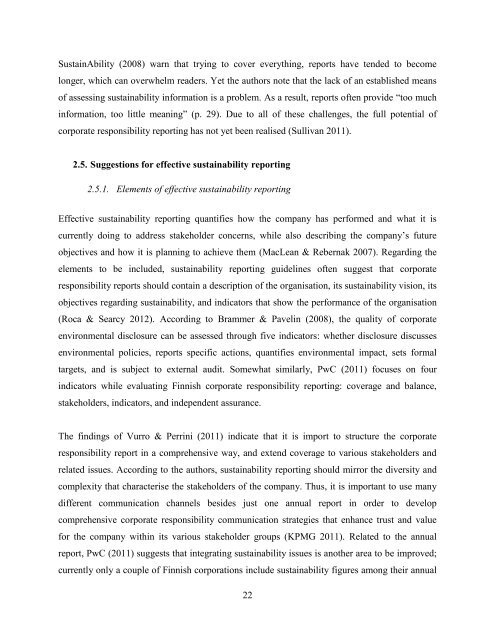Developing sustainability reporting - Case Cargotec - Aaltodoc
Developing sustainability reporting - Case Cargotec - Aaltodoc
Developing sustainability reporting - Case Cargotec - Aaltodoc
Create successful ePaper yourself
Turn your PDF publications into a flip-book with our unique Google optimized e-Paper software.
SustainAbility (2008) warn that trying to cover everything, reports have tended to become<br />
longer, which can overwhelm readers. Yet the authors note that the lack of an established means<br />
of assessing <strong>sustainability</strong> information is a problem. As a result, reports often provide “too much<br />
information, too little meaning” (p. 29). Due to all of these challenges, the full potential of<br />
corporate responsibility <strong>reporting</strong> has not yet been realised (Sullivan 2011).<br />
2.5. Suggestions for effective <strong>sustainability</strong> <strong>reporting</strong><br />
2.5.1. Elements of effective <strong>sustainability</strong> <strong>reporting</strong><br />
Effective <strong>sustainability</strong> <strong>reporting</strong> quantifies how the company has performed and what it is<br />
currently doing to address stakeholder concerns, while also describing the company’s future<br />
objectives and how it is planning to achieve them (MacLean & Rebernak 2007). Regarding the<br />
elements to be included, <strong>sustainability</strong> <strong>reporting</strong> guidelines often suggest that corporate<br />
responsibility reports should contain a description of the organisation, its <strong>sustainability</strong> vision, its<br />
objectives regarding <strong>sustainability</strong>, and indicators that show the performance of the organisation<br />
(Roca & Searcy 2012). According to Brammer & Pavelin (2008), the quality of corporate<br />
environmental disclosure can be assessed through five indicators: whether disclosure discusses<br />
environmental policies, reports specific actions, quantifies environmental impact, sets formal<br />
targets, and is subject to external audit. Somewhat similarly, PwC (2011) focuses on four<br />
indicators while evaluating Finnish corporate responsibility <strong>reporting</strong>: coverage and balance,<br />
stakeholders, indicators, and independent assurance.<br />
The findings of Vurro & Perrini (2011) indicate that it is import to structure the corporate<br />
responsibility report in a comprehensive way, and extend coverage to various stakeholders and<br />
related issues. According to the authors, <strong>sustainability</strong> <strong>reporting</strong> should mirror the diversity and<br />
complexity that characterise the stakeholders of the company. Thus, it is important to use many<br />
different communication channels besides just one annual report in order to develop<br />
comprehensive corporate responsibility communication strategies that enhance trust and value<br />
for the company within its various stakeholder groups (KPMG 2011). Related to the annual<br />
report, PwC (2011) suggests that integrating <strong>sustainability</strong> issues is another area to be improved;<br />
currently only a couple of Finnish corporations include <strong>sustainability</strong> figures among their annual<br />
22
















